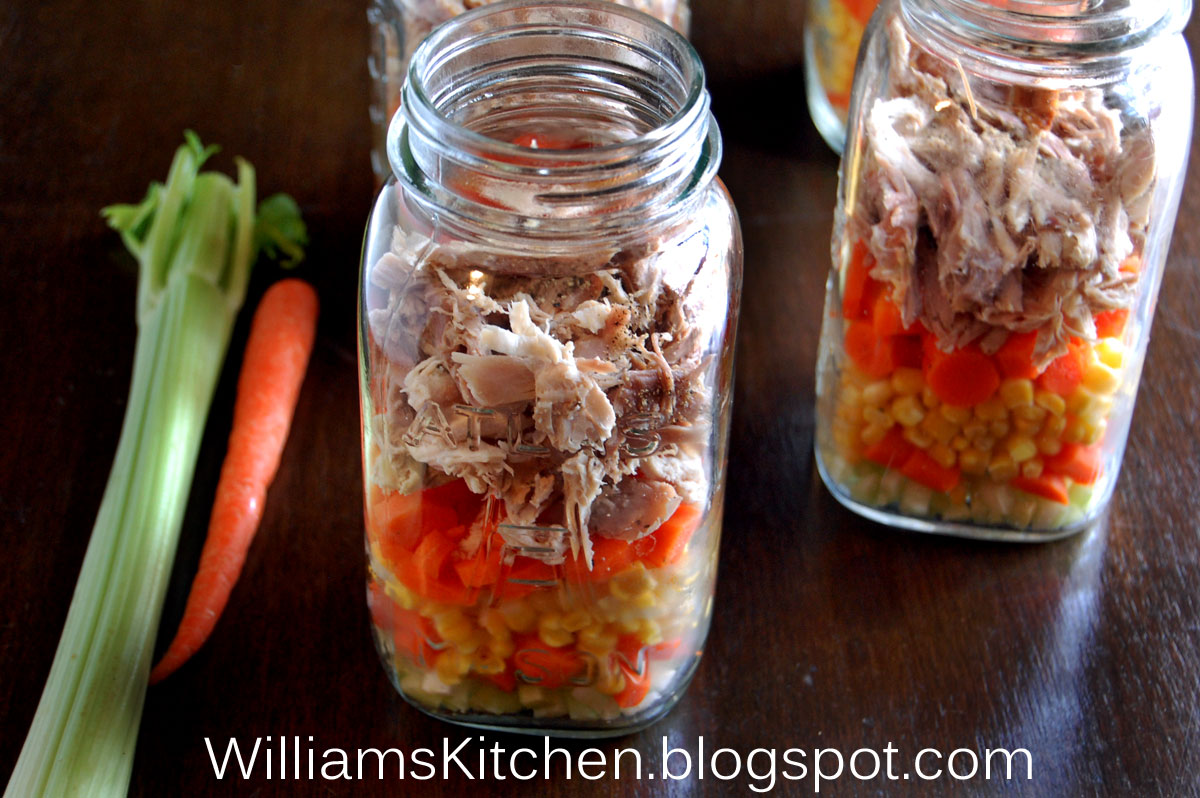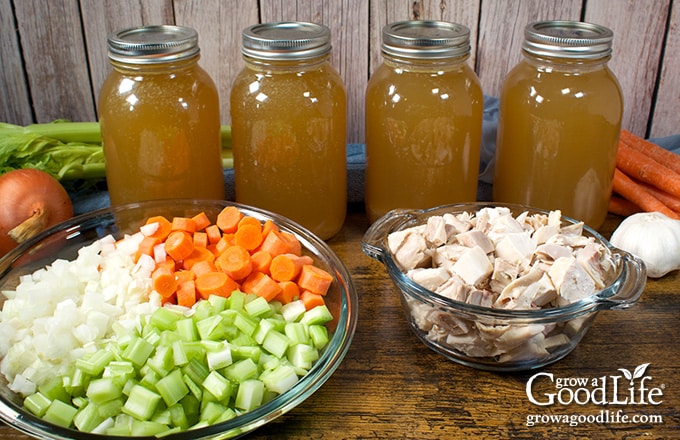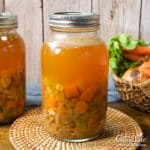Preserve the warmth of homemade comfort with our guide to canning turkey soup! Stock your pantry and savor the convenience of homemade soup anytime with this safe canning recipe.
There’s something comforting about a steaming bowl of homemade soup, especially when it’s made with care and preserved to be enjoyed when the craving strikes. In this recipe, you’ll learn how to safely pressure can a wholesome and hearty staple for your pantry—Turkey Soup.
Leftover turkey is one of the best parts of the Thanksgiving meal, but one of my favorite ways to use up leftovers is to turn them into home-canned turkey soup that we can enjoy all winter. In fact, I get an extra turkey so I can roast it up and use the meat for canning plain turkey meat, preserving turkey soup, and turning the bones into a delicious, rich turkey stock.
Canning your own turkey soup not only provides a convenient and timesaving solution at mealtime, but also guarantees a flavor-packed soup that surpasses store-bought alternatives with no additives or mystery ingredients.
Canning turkey soup is a great way to preserve and extend the flavors of Thanksgiving. Making and canning a hearty turkey soup means you can enjoy delicious turkey soup all winter long. Read on for everything you need to know about canning turkey soup at home.
Benefits of Canning Turkey Soup
There are many benefits to canning your own turkey soup after Thanksgiving
-
Preserves Turkey Leftovers – Don’t let your turkey go to waste! Canning it makes turkey last for up to 2 years
-
Save Money – Canned soup costs 3-4 times more than homemade, Canning your own is frugal,
-
Quick Weeknight Meals – Just open a jar for fast soup ready in minutes. It’s so convenient.
-
Control Ingredients – Make wholesome soup without preservatives or additives.
-
Unique Holiday Gifts – Homemade canned soup makes thoughtful gifts for neighbors and family.
Tips for Canning Turkey Soup
Follow these tips for safely canning flavorful and shelf-stable turkey soup:
-
Use a Pressure Canner – A pressure canner is required to safely can soup at home. The high heat kills bacteria.
-
Use Homemade Turkey Stock – For the best flavor, make turkey stock from the bones and use it in the soup.
-
Cut Turkey in Bite-Sized Pieces – Dice the turkey into 1/2 to 1 inch cubes so the meat is evenly distributed.
-
Pack Jars Carefully – Fill jars halfway with turkey and vegetables, then pour in hot broth, leaving 1 inch headspace.
-
Don’t Add Noodles – Only add dried pasta, rice or noodles when reheating as they soak up too much liquid.
-
Adjust for Altitude – Increase canner pressure for higher elevations based on manufacturer guidelines.
-
Don’t Change Recipe – Only make safe tested recipes from trusted sources like the USDA or Ball canning guides.
-
Check Seals – Make sure jar lids sealed properly before storing. Refrigerate unsealed jars immediately.
-
Label & Store – After cooling, label jars with contents and date. Store in a cool, dark place up to 2 years.
Step-by-Step Guide to Canning Turkey Soup
Follow these simple steps for safely canning stellar turkey soup at home:
1. Prep the Turkey & Vegetables
-
Cook turkey pieces until no longer pink and dice into bite-sized 1/2 to 1 inch cubes.
-
Chop onions, carrots, celery, and any other vegetables into small uniform pieces for even cooking.
2. Make the Turkey Broth
-
Simmer turkey carcass and scraps in water with seasonings to extract flavor and make broth.
-
Let cool and strain out bones. Skim off excess fat from the top before using.
3. Prepare Equipment & Jars
-
Wash canning jars, rings, and new lids in hot soapy water. Rinse. Place jars in canner filled with 2-3 inches water.
-
Add canner rack, fill with water based on manufacturer guidelines, and bring to a simmer. Keep jars hot until ready to fill.
4. Make the Soup
- Add diced turkey, prepared vegetables, and seasonings to broth in a pot. Simmer until vegetables are tender.
5. Pack the Jars
-
Use a canning funnel to fill hot jars halfway with turkey and vegetables. Ladle in hot broth, leaving 1 inch headspace.
-
Slide bubble releaser down jars to remove trapped air. Wipe rims. Apply lids and rings.
6. Pressure Can the Jars
-
Place jars on canner rack. Lock canner lid. Vent steam 10 minutes. Close vent. Raise pressure to 11 PSI.
-
Process quart jars for 75 minutes, pint jars for 60 minutes. Adjust for altitude over 1,000 ft if needed.
-
When time is up, turn off heat. Allow canner to depressurize naturally. Wait 10 minutes then open lid away from you.
-
Remove jars. Allow to cool untouched for 12-24 hours. Check seals, then store.
7. Enjoy Your Turkey Soup!
- To serve, pour into pan and simmer 10 minutes. Add rice, noodles or veggies. Season to taste. Enjoy your homemade soup!
Delicious Turkey Soup Recipe for Canning
This versatile recipe makes about 7 quarts of hearty turkey soup perfect for pressure canning:
Ingredients:
- 6 cups cooked, diced turkey
- 3 cups sliced carrots
- 3 cups chopped celery
- 2 cups diced onion
- 4 cloves garlic, minced
- 1 Tbsp dried thyme
- 2 bay leaves
- 1 Tbsp whole black peppercorns
- 1 Tbsp salt (optional)
- 8 cups turkey broth or stock
Directions:
-
Prepare turkey and vegetables. Place in large pot. Add seasonings.
-
Pour in broth and bring to a boil. Reduce heat and simmer 30 minutes.
-
Carefully ladle hot soup into jars leaving 1 inch of headspace. Wipe rims. Apply lids and rings.
-
Pressure can quart jars for 75 mins, pint jars for 60 mins at 11 PSI.
-
Cool jars completely undisturbed for 12-24 hours. Check seals.
-
Store sealed jars in cool, dark place up to 2 years.
-
To serve, simmer soup 10 minutes. Add rice or noodles. Adjust seasonings.
Tips for Reheating & Serving Canned Turkey Soup
Follow these tips for safely reheating and enhancing your homemade canned turkey soup:
-
Simmer for 10 Minutes – Always heat canned soup for at least 10 minutes before eating to kill any bacteria.
-
Add Noodles or Rice – For a heartier soup, cook noodles, rice, or pasta separately and add to your bowl before ladling in hot soup.
-
Toss in Veggies – Customize your soup by adding fresh or frozen vegetables like spinach, kale, peas, corn or beans while reheating.
-
Garnish with Herbs – Brighten up your soup with a sprinkle of chopped fresh parsley, thyme, rosemary or sage.
-
Swirl in Cream – Stir in a spoonful of heavy cream or milk just before serving for a creamy richness.
-
Season to Taste – Tailor the flavor with a little salt, pepper, hot sauce or a squeeze of lemon juice.
-
Make it a Meal – Round out your soup into a complete meal by serving it with a salad, bread and a glass of wine or cider.
Storing & Preserving Your Canned Turkey Soup
Follow proper storage methods to keep your homemade canned turkey soup safe and shelf-stable:
-
Test Seals Before Storing – Make sure jar lids are sealed correctly by pressing down on centers. If they pop or flex, they didn’t seal. Refrigerate these immediately.
-
Remove Rings – Take off the screw bands before storing sealed jars. This allows you to easily check seals and see if any rust or food discoloration occurs over time.
-
Label Jars – Identify contents and date each jar before putting it away. Store jars without screw bands.
-
Store in Cool, Dark Place – For best quality and safety, store properly sealed jars in a cool, dark place between 50°F to 70°F for up to 2 years.
-
Use Oldest Jars First – Be sure to use oldest canned soup jars first to avoid any quality or safety issues. Discard any jars with mold, rust or food discoloration.
-
Refrigerate After Opening – Once opened, refrigerate leftover soup and use within 3 to 5 days. Never re-can opened soup. Simply freeze leftovers in airtight containers.
Troubleshooting Problems with Canned Turkey Soup
Use this troubleshooting guide if you run into any issues with your pressure canned turkey soup:
Problem: Floating Food
- Cause: Too much headspace in jars
- Solution: Carefully pack jars tighter before canning
Problem: Cloudy Broth
- Cause: Starch from pasta/rice added before canning
- Solution: Only add noodles, rice or pasta when reheating soup
Problem: Discolored Soup
- Cause: Iron and sulfur compounds in water
- Solution: Use soft or distilled water for clearer canned soup
Problem: Moldy Soup
- Cause: Food particles left on sealing surface
- Solution: Carefully clean rims and use new lids each time
Problem: Unsealed Lids
- Cause: Food debris on rims or lids put on incorrectly
- Solution: Thoroughly clean rims and seal lids properly
Problem: Flat-Sour Spoiled Soup
- Cause: Pressure canner failure
- Solution: Use tested safe recipes and functioning dial/weighted pressure canner
Enjoy Delicious Homemade Turkey Soup All Season
Preserving turkey soup through pressure canning lets you enjoy scratch-made soup conveniently for months after Thanksgiving

Steps to Canning Turkey Soup
You’ll need a pressure canner to can turkey soup safely. It’s the only way to get the high temperatures required to kill harmful bacteria that cause foodborne illnesses. If you don’t have a pressure canner, you can still follow this recipe. Just freeze the soup instead.
Before you start, familiarize yourself with the Using Pressure Canners guide on the National Center for Home Food Preservation website. Also, please review the instructions for your pressure canner and ensure it’s all clean and working fine.
This recipe is developed based on the basic Soup recipe from the USDA Complete Guide to Home Canning, So Easy to Preserve, and the National Center for Home Food Preservation. These guidelines call for packing the jars half full with the solid ingredients, then filling them with liquid and leaving a 1-inch headspace. It may seem like a lot of liquid, but it is the perfect amount for heating and ladling over noodles or rice at serving time.
- Turkey Meat: This recipe calls for cooked turkey. If you start with raw turkey, precook it by cutting it into cubes and simmering it in a skillet with some turkey broth or water. As a rough estimate, you will need around 3 to 3 1/2 pounds of raw boneless turkey meat to yield 6 cups of diced cooked turkey.
- Vegetables: This recipe uses the classic trio of mirepoix veggies—celery, onions, and carrots. Yet, feel free to swap these out for an equal amount of alternatives like asparagus, green beans, corn, mushrooms, thawed frozen peas, peppers, tomatoes, or turnips.
- Seasonings: This recipe uses the classic Bells poultry seasoning. However, you can use dried herbs like thyme, rosemary, oregano, or basil, but keep in mind that sage turns bitter when canned.
- Broth Liquid: I like using homemade turkey stock to add flavor to the soup, but you can use vegetable broth, chicken bone broth, or simply water – your choice. If you don’t have turkey broth or stock on hand, you can make it from the turkey carcass and roasting pan juices the day before by following this Turkey Stock Recipe. Once the stock cools in the refrigerator, the fat will rise to the top and can be easily removed before using it to make your soup.
- Caution: Do not include noodles, pasta, rice, flour, cream, milk, or other thickening agents to home-canned soups. Instead, add these when you open the jar and heat the soup at serving time.

Enjoy Your Homemade Turkey Soup!
Congratulations on your freshly canned turkey soup! Now, enjoy the convenience of a quick, hearty meal whenever you crave the comforting warmth of homemade soup. Here’s how to make the most of your culinary creation:
When hunger strikes, open a jar of your home-canned turkey soup and add it to a medium saucepan. Heat it on the stove for approximately 10 minutes. Don’t hesitate to customize it by adding extra veggies, fresh herbs, or a dash of your favorite spices. I enjoy tossing in a handful of fresh spinach, frozen broccoli, or any leftover veggies from the fridge.
Explore various ways to elevate your turkey soup after opening the jar:
- Turkey Noodle Soup: Elevate your meal by turning your canned turkey soup into turkey noodle soup. Cook the noodles separately in a pot, drain them, and add the noodles to your bowl. Then, generously ladle the piping-hot soup over the noodles. Cooking the noodles separately prevents them from absorbing all the delicious chicken stock. Prepare about 1/2 cup to 3/4 cup of dried noodles per quart.
- Turkey and Rice Soup: If you prefer a heartier base, try turkey and rice soup. Cook your rice separately, and add the cooked rice to your bowl at serving time. Ladle the hot turkey soup over the rice and stir to combine the flavors. This variation adds a satisfying depth and texture to your soup, creating a wholesome meal in a bowl. Prepare approximately 1/4 to 1/3 cup of uncooked rice per quart jar.
- Additional Serving Ideas: Feel free to experiment with other additions to suit your taste. Consider tossing in a handful of cooked quinoa, barley, or even orzo at serving time for added texture. Garnish your soup with a sprinkle of fresh parsley, a drizzle of olive oil, or a squeeze of lemon juice to enhance the overall flavor.
The versatility of your home canned turkey soup allows for endless creativity and personalization at serving time. Whether enjoyed on its own or with these suggested variations, your soup will become a staple in your home, offering a quick meal, comfort, and nourishment with every spoonful.

Pressure Canning Leftover Thanksgiving Turkey Leftovers into Turkey Soup/casserole Starter.
FAQ
Can homemade soup be canned?
Does turkey broth need to be pressure canned?
Should soup be cooked before canning?
Do you have to cook turkey before canning it?
